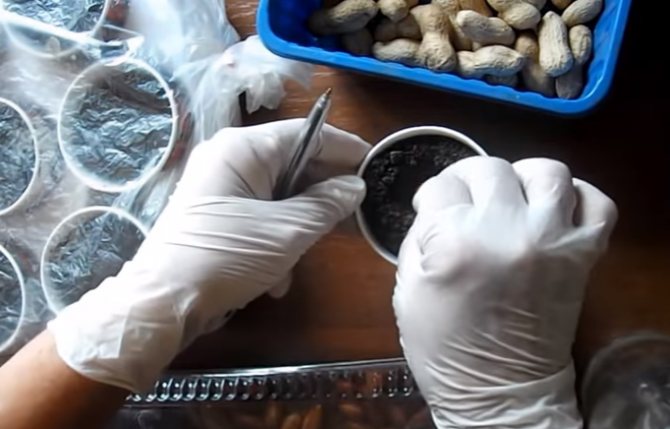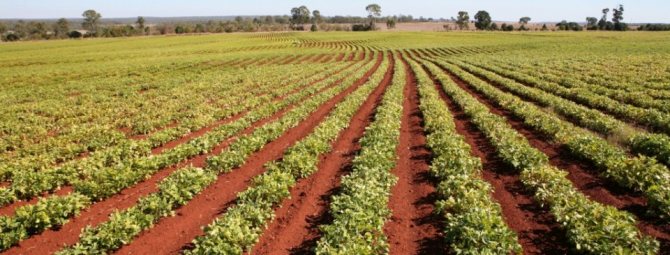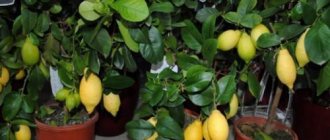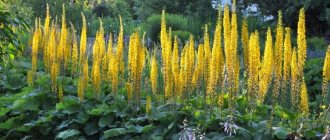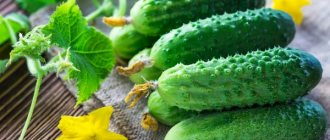Bored home-grown agronomists should plant peanuts, if only for the sake of observing the strange development of the ward. A peanut grows on a bush with lush greenery and shoots in the lower third, extending into the ground. These genophores appear after a one-day flowering and hide the ovaries from the scorching sun of hot countries, from which beans will form in 120-150 days. How to plant peanuts in an apartment, dacha, get and save the harvest of a high-protein product, we will tell below.
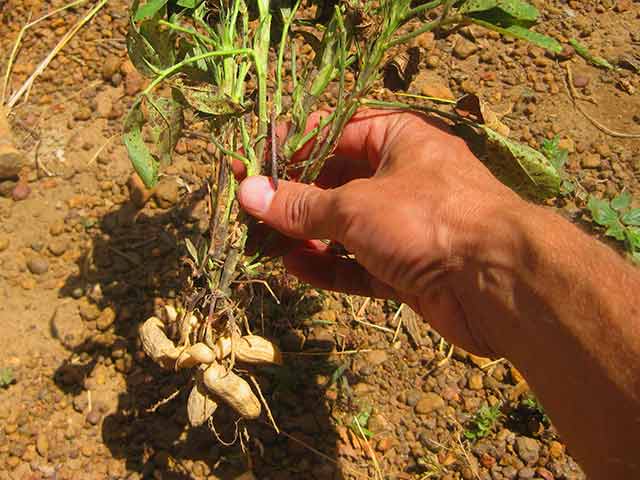
Peanuts: growing in the middle lane


The name of this nut comes from the Greek word "arachne", which means "spider". Somewhat unusual, isn't it? However, everything is explained very simply - a cobweb-like pattern is clearly visible on its shell. Although it can be called a nut very conditionally, since it belongs to the oilseed crops and the legume family.
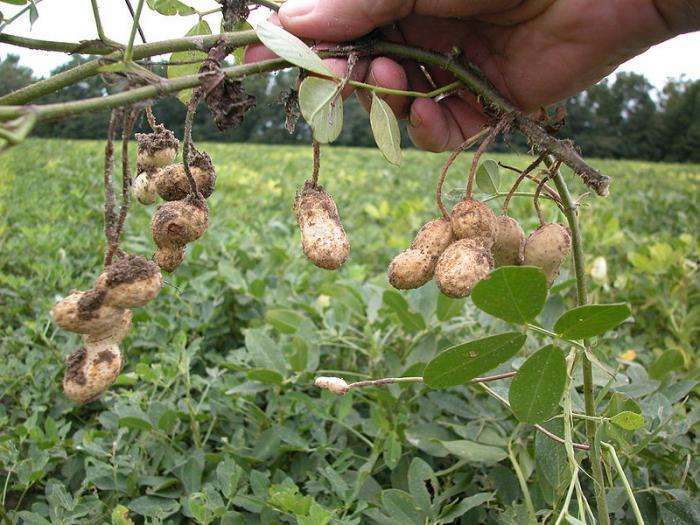

Growing conditions
To plant a groundnut (peanuts) and get a good harvest, simple growing rules will help:
- For peanuts, the color of the soil is very important. A plant planted in light soil takes root better. The oil obtained from these beans is also light in color and is more expensive than dark.
- The fruits develop in the ground, so the soil must be loose. The most suitable composition is black soil, neutral or sandy loam.
- Peanuts grow better in beds where cucumbers, tomatoes, cabbage and potatoes were previously sitting. It is not recommended to plant beans after related crops (beans, peas, lentils).
- The most comfortable temperature is 20-27⁰С. If the value drops below 15⁰, or rises above 30⁰, the plant will stop growing.
- During flowering and fruit development, peanuts need constant moisture. However, water should not be allowed to stagnate, as it can slow down the seed ripening process.
- The beds where the peanuts are sitting should be ventilated.
- The plant loves sunny places, so peanuts should be planted in open areas without shade.
If you neglect at least one condition, the plant will start to hurt. Stains will appear on its foliage - direct evidence of the development of root rot.
How peanuts usually grow
You do not need to remove the shell from them. Soak the nuts in water, then place them on a cloth and wait for the sprouts to appear. As soon as they appear, you can plant the nuts in the soil. Planting peanuts is done in moist, loose soil with little sand. You need to know that this plant is thermophilic, so it is advisable to soak it in April. In this case, it will actively develop during the summer months. During this period, it grows most intensively. But if you risk planting it at a later date, then you will need to carefully monitor the temperature and lighting.
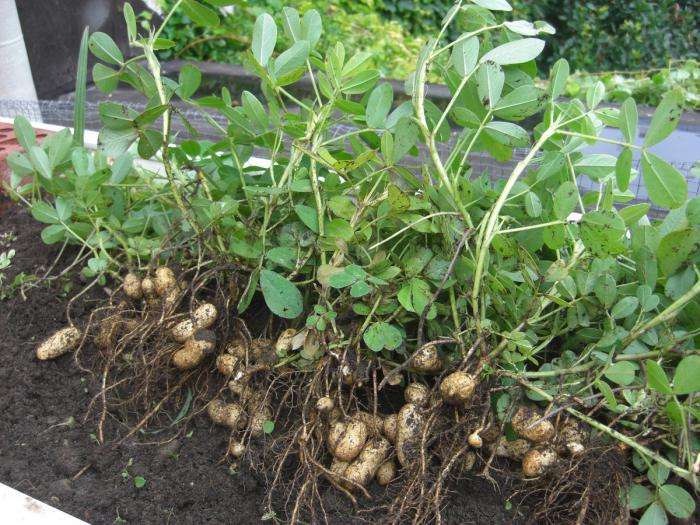

Diseases and pests of peanuts
Of the diseases, peanuts are threatened by:
- powdery mildew. It manifests itself as a localized white bloom on both sides of the leaf, in advanced stages - on fruits and stems. Removed by ready-made means - "Switch", "Horus", "Quadris";
- gray rot is brown spots. As a preventive measure, at the end of summer, peanuts are protected from high humidity;
- Alternaria is also a consequence of excessive moisture.They recognize the disease by black spots - over time they merge and lead to the death of leaves;
- Fusarium wilting threatens those plants that develop under inappropriate conditions. Observe agricultural techniques, otherwise brown rot will lead to the death of the "pet".
Of the existing pests for peanuts, wireworms are the most dangerous. The larvae living in the soil make their way through the pod shell and eat the beans. To grow a peanut, wireworms are trapped. Periodically lay out the remains of potatoes, carrots and beets in the holes around the bush, cover with a board. After 10 days, destroy the pieces of vegetables along with the collected larvae.
A mixture of equal parts of wood ash and tobacco crushed into dust saves from caterpillars and aphids on the leaves. Thrips are fought with ready-made preparations from the store.
Necessary care
We talked about the fact that caring for the plant is not too difficult, but this does not mean at all that it is enough to plant peanuts in a pot and put them on the balcony. How do you plant it so that you get valuable fruit as a result? During flowering, the plant needs abundant watering, and after its end, much less water will be required. During the flowering period, the plant is able to decorate any greenhouse - bright yellow-orange flowers appear on it. When they fall, gynophores appear in their place - processes that grow up for a while, and then rush to the ground. Having entered it, they form ovaries, from which a nut is formed later in the ground.
Novice flower growers and gardeners should know that genophores are not always able to reach the ground themselves. Therefore, for very tall plants, you can use ordinary egg shells filled with soil, which should be substituted for the genophores. As soon as the leaves on the plant begin to turn yellow, this means that the nuts are fully ripe and can be removed from the soil. Peanuts are an annual plant, therefore, having received a harvest, you will have to part with them.
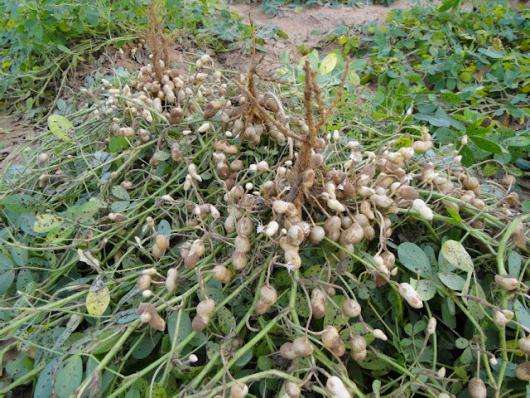

Description of the peanut plant
An annual vegetable plant, which self-pollinates, rises above the soil as a lush green bush up to 60-70 cm.Rotal roots with many shoots provide sufficient nutrition for upright stems, which are found in different varieties of peanuts:
- pubescent or naked;
- with slightly protruding edges;
- with branches that go up during flowering or descend after the formation of bean buds.
Alternate, pubescent leaves of different lengths: 3-5 or even 10-11 cm. Consist of several pairs of oval leaf blades, with a slightly pointed tip.
Pedicels emerge from the axils of the leaves, bear 4-7 flowers of the moth type, which is typical for legumes, which include peanuts. The petals are whitish or deep yellow. The peanut flower only blooms for a day. If pollination occurs, bean ovaries begin to form. At the same time, a gynophore, a receptacle area, grows, and as the branch tilts, it grows into the ground, pulling along with it the miniature bean ovary to a depth of 8-9 cm. Schematic pictures show how peanuts grow. One bush can produce up to 40 or more beans.
Usually, the beans are formed only from the peanut flowers located at the bottom of the bush. And also from the so-called cleistogamous flowers that the plant creates underground. Apical flowers, above 20 cm from the surface of the earth, do not bear fruit. Not all gynophores with bean ovaries grow into the ground, some simply dry out.
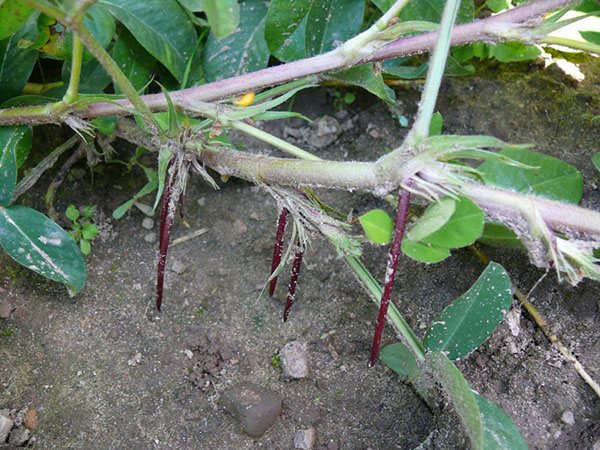

Attention! Peanuts bloom from the last decade of June to autumn. The first flowers that are at the bottom of the bush are fertilized.
The fruits are oblong, swollen beans, with bandages, 2-6 cm long, with a wrinkled peel of a nondescript sandy color. Each contains from 1 to 3-4 bulky seeds.Grains from 1 to 2 cm, oval, with a reddish-brown husk that easily separates after processing. The seeds consist of two hard cream-colored cotyledons.
Outdoor cultivation
Planting peanuts on a personal plot is not much different from growing it at home. In the southern regions of our country, germinated kernels can be planted in open ground in mid or late May, when the air temperature is set at around +20 - +25 degrees. During the summer months, the plant will develop well and you will harvest quality peanuts. How to plant a nut in more northern latitudes? In this case, it is more advisable to use seedlings, which must be started to grow in early April, and at the beginning of June they can already be planted in open ground.
Pay attention to where your peanuts will grow. How to plant it most successfully? This should be an open, well-lit garden bed, on which potatoes, cucumbers, cabbage were previously grown, but by no means other legumes.
In the Urals and Siberia
Since the climate of the Urals and Siberia differs significantly from the middle zone of Russia, the cultivation of peanuts in these regions has its own characteristics:
♦ South Ural - it is quite easy to grow a culture. To do this, in the fall, they dig up a garden bed and apply fertilizers to it. In April, the finished bed is covered with a film to accelerate the heating of the soil. In early May, seeds are planted and covered with foil again. When the weather is stable and warm, the beds are opened, and after the appearance of the first flowers, they huddle, sprinkling the whole plant with earth (except for a few upper leaves). In the future, hilling is repeated until about mid-August, when the bushes form closed rows.
♦ Middle Urals - the cultivation technique is the same, but you only need to plant seeds in warm beds. To do this, a trench is dug, plant waste and compost are placed in it and mixed with the top layer of soil. As the plants decompose, they begin to generate heat. In the spring, seedlings are planted and kept under a film until the leaves appear. Further care is no different.
♦ Northern Ural - you can only grow a nut in a greenhouse, planting it between other plants (for example, between tomatoes). Since the nut requires a minimum of space, such a planting may well bring a small crop.
The difficulties of growing in Siberia are primarily related to the fact that this crop is thermophilic and simply will not bear fruit in cold climates. To do this, equip warm beds.
When growing peanuts in Siberia, do the following:
♦ Prepare the beds in advance. The earth is dug up and fertilized. The site should be located in the most illuminated place, preferably with loose light soil.
♦ Seed preparation. If you are not planning to grow peanuts from seedlings, you can simply sprout the beans by wrapping them in a damp cloth.
♦ Landing. Seeds are covered with foil until stable warm weather sets in. Seedlings are often loosened, and watering is reduced up to 8 times over the entire growing season, and they are completely stopped 3 weeks before harvesting.
There are bush and creeping varieties. For Siberia, a bush is more suitable, since after flowering it forms an ovary, which sinks into the ground for the formation of fruits. In addition, it is better to choose early varieties, the fruiting period of which is only 3 months.
There are currently 700 varieties of peanuts.
Harvesting
When the bushes begin to dry out, you can harvest the walnut. This usually happens in early October. The day you start harvesting, the weather should be sunny and warm to keep the soil completely dry. By the way, a week before that, watering the plant should be completely stopped. In this case, the bush will come out easily. It is more convenient to dig out peanuts with a pitchfork - gently pry the rhizome so that the nuts remain on the bush.
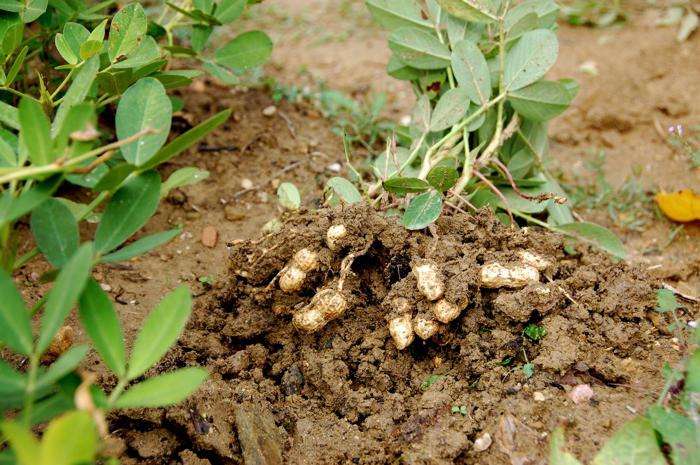

Spread the dug out plants for 2-3 days in a dry, well-ventilated area. Then the cocoons with nuts can be collected and left at room temperature until completely dry. You will learn about this by shaking the cocoon - the nuts should roll freely in it.
Stage two. Choosing and preparing planting material
To get the greatest yield, give preference to zoned varieties. Buy them from a reliable gardening store or alternatively from friends or neighbors. As seeds, not only beans (crushed / whole) can be used, but also husked seeds.
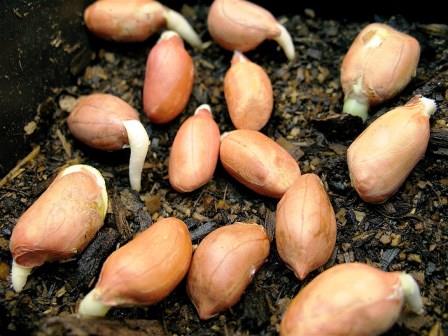

Planting material
The most common varieties of peanuts in temperate climates include the following:
- Stepnyak;
- Klinskaya;
- Krasnodarets 14;
- Valencia 433.
Note! When buying, be extremely careful so that you do not slip fried or otherwise processed grains. Otherwise, time and money will be wasted.


Preparation of planting material for peanuts
Groundnuts can be grown both by sowing in open soil and through seedlings. If you prefer the first option, then use only those seeds that were harvested no more than 2 years ago (germination is lost over the years). Regardless of the chosen method, the grain must be germinated around the last days of April. To do this, follow the instructions below.
Step one. Take the seeds and immerse them in a weak solution of potassium permanganate for 15 minutes to disinfect.
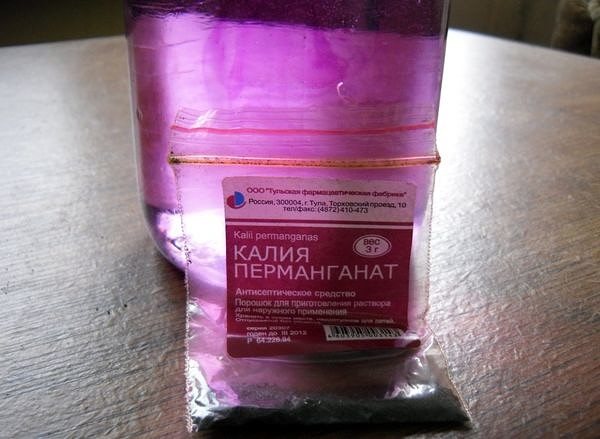

Potassium permanganate solution
Step two. Rinse the seeds with running water and soak for germination. After 10 days, the first shoots are formed.
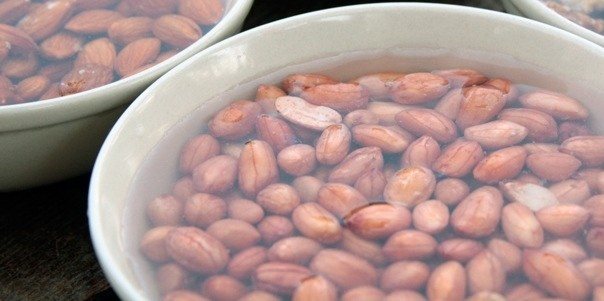

Soak
Step three... Temper the resulting sprouts. To do this, during the day, keep them in a room with a temperature of the order of 3 ° C for several days, but transfer them overnight to where the temperature is at room temperature.


Sprouts
History
The homeland of peanuts is South America. It was there that he first appeared, there he was used long before these lands were discovered by Europeans. It occupied an important place in the diet of the Aztecs and other indigenous Indians of South America and Mexico.
Spanish and Portuguese researchers, who saw how peanuts grow in the New World, brought this plant to the African continent. It has become widespread in many African countries and has become part of local traditional food cultures. Because it was revered as a sacred food, African slaves took it with them during the slave trade. This is how he first came to North America.
Also, thanks to the Portuguese, the peanut plant appeared in India and Macau, and thanks to the Spaniards - in the Philippines.
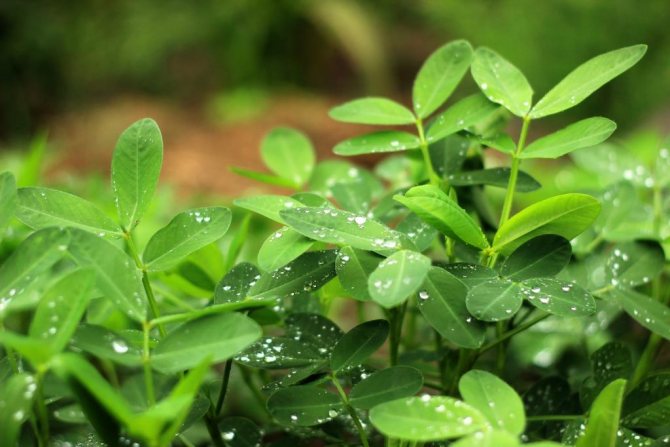

How does a peanut grow?
They are recommended as a supportive agent in the nutrition of malnourished patients, and the rich composition of minerals allows them to be used in the diet of people engaged in increased mental work. Pistachios replenish the body with fiber, help with liver diseases, clear bile ducts from blockages, they are useful for respiratory diseases. Pistachios reduce the absorption of cholesterol from food and improve vascular elasticity. If you take pistachios regularly, you can reduce your predisposition to cardiovascular disease. Unsurprisingly, pistachios have been listed on the Food and Drug Administration's dietary guidelines since 2003.
And pistachios are also called "rejuvenating nuts". The fact is that the phenolic compounds contained in them provide antioxidant ability and, by preventing free radicals from destroying cell walls, preserve the youth of the body.
Pistachios come to Ukrainian buyers from Iran and the United States: in January-August this year, our country bought 1.4 tons of "rejuvenating nuts" at an average price of $ 3.42 per kilo. Not surprisingly, pistachios are off the charts in supermarkets!
EARTHNUT (PEANUT)
2.5 times cheaper - at $ 1.24 / kg - we buy peanut... Judging by the volume of purchases, our person peanut respects: in the first 8 months of this year alone, Ukraine bribed - neither more nor less - 22 tons of nuts, half of which came from India.
Peanuts, or peanuts, contain many beneficial trace elements and vitamins necessary for the normal functioning of the body. Peanuts help regulate blood sugar levels, normalize blood pressure and metabolic processes in the human body. Peanuts are also considered a natural immune-boosting product that can help fight negative reactions of the body to everyday stress and depression. Peanuts are also uplifting and useful for those who want to focus on solving an important task.
What are the varieties of peanuts
Few people know how a peanut grows. The success of growing a crop depends on the variety chosen, as well as weather conditions. Therefore, before planting, it is very important to choose the right nuts that are suitable for the local climate. The quality of the fruit and the amount of the harvest will directly depend on this.


Each type of peanut has its own strengths and weaknesses, which should definitely be studied before planting a seed. There are 4 main types in total. Among them:
- Virginia. Selected variety with the brightest taste. It grows no more than 55 cm. It is best to use fried nuts;
- Valencia or Redskin. Their shoots are reddish. They rise up to 1 meter. In ripe pods there are 3 nuts each, which are covered with red skin;
- Spanish. Nuts, in comparison with other varieties, contain a large percentage of oil. The fruits are of medium size and yield. Spanish is often found in modern stores as a fried savory snack;
- Runner. The variety is distinguished by large fruits. Subject to all the rules of care, the peanut bush has a high yield. Nuts have a rich taste. This quality allows them to be used for oil production or simply consumed in salted form.
For growing peanuts in Russia, the Otradokubansky variety is best suited. It was launched in 2005.
It is interesting!
Each variety of peanuts has its own advantages and disadvantages. To grow a plant on your own and get a good result from a bush, you must be able to grow it correctly, as well as follow certain rules for caring for it.

